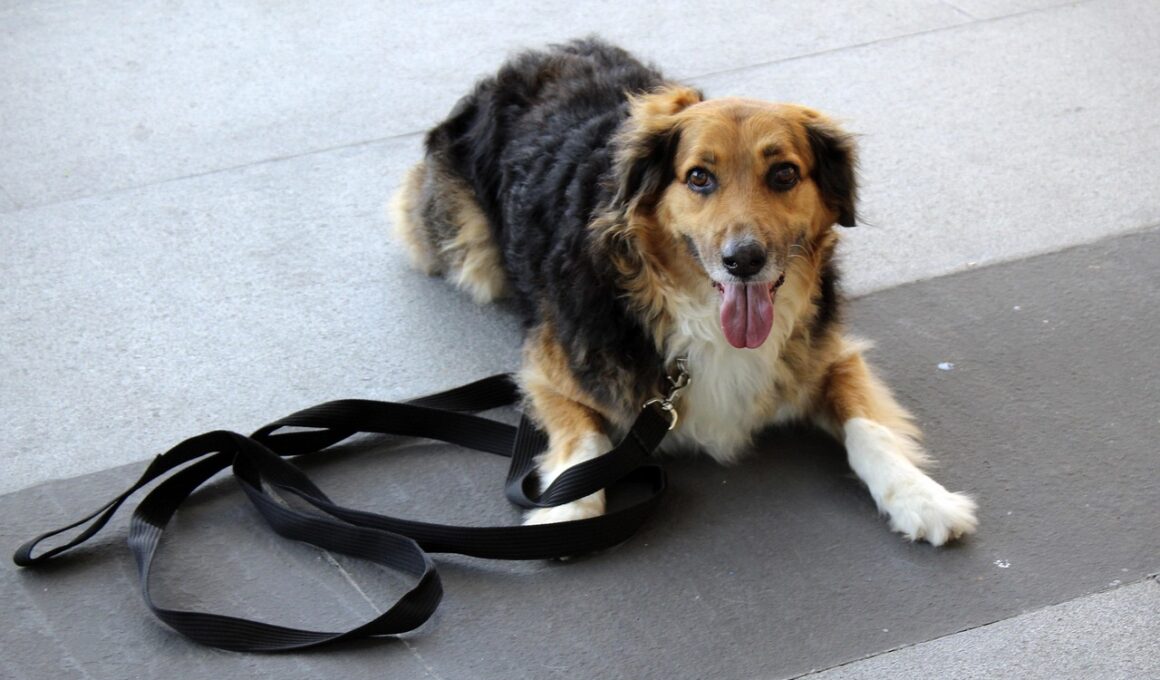How Consistency Improves Your Dog’s Understanding of ‘Off’
Training your dog using the command ‘off’ can greatly enhance their behavior in various situations. This command is primarily used to prevent jumping on furniture or people, which is essential for maintaining control and ensuring safety. Consistency is key in this training; dogs thrive on routine, and when they receive the same command repeatedly, they begin to understand its meaning. Always use the same command – ‘off’ – to avoid confusion. Reinforce this command with positive reinforcement, such as treats or praise, every time your dog complies. This not only strengthens the bond between you and your dog but also helps your canine associate the command with rewarding outcomes. When you allow them to practice the command in different environments, they grasp its significance even better. Consistent training helps set clear expectations and guidelines. Utilize moments when your dog jumps up, allowing teaches them the command while offering corrections gently. A calm demeanor and patience will promote learning. Finally, persistence in practicing this command every day leads to more independent and well-behaved dogs, ensuring that they respect personal spaces and the boundaries you’ve set.
Understanding Dog Behavior
Dogs communicate largely through body language, behavior, and vocalizations. Understanding these signals enables you to be more effective in training them. When teaching the ‘off’ command, observe how your dog reacts to different situations. For instance, if your dog jumps up, immediately use the command, and redirect them to a proper behavior, like sitting. Identifying their triggers will help you intervene more effectively. Dogs learn through associations; if they continuously jump and receive attention, they will view it as positive reinforcement. To combat this, reinforce acceptable behaviors by using commands like ‘sit’ or ‘stay’. Establish clear boundaries so your canine companion comprehends where they’re not allowed, such as couches or beds. By providing alternative actions that are rewarded, they will be less inclined to jump. Consistency in using the command during various activities aids in understanding and retention. Think about using visual cues alongside the verbal command to strengthen the learning process. Repetitive exposure to the command reinforces the desired reaction. Over time, dogs begin to generalize the command and associate it with specific actions beyond their initial training.
Training sessions should be short and engaging to retain your dog’s attention. Ideally, 10 to 15 minutes is a perfect duration for a focused training session. Enjoyable sessions allow for better learning through positive experiences, resulting in a better understanding of the command ‘off’. When a dog feels pressure or discomfort during training, they can develop negative associations with the process. Maintain a fun atmosphere with plenty of pats and encouragement. Adding variety helps in keeping your dog engaged, so mix up your training locations or incorporate different activities. Each training session should build on the previous ones, reinforcing past commands while integrating new ones. Always conclude the session with positive notes, as dogs respond well to rewards and praise. Make sure to allow ample time for practice in daily routines by reinforcing the command during outings or playtime. Redirecting your dog can also pay off in the long run; reinforce the ‘off’ command after they encounter distractions. Interaction with other dogs or people might pique their interest, so stay alert. Remember that every interaction is a learning opportunity. Utilizing everyday opportunities ensures steady growth and helps in forming lasting habits through consistency.
For optimal learning, it’s vital to create an encouraging atmosphere for your dog. Ensure your dog feels relaxed and secure during training. A stressed dog will not respond well to commands, making it harder for them to understand. Choose a quiet area free from distractions to begin your training. Maintaining a calm energy yourself promotes relaxation and focus in your dog. When they are in a new environment, approach training with understanding; they need to familiarize themselves with their surroundings. Provide frequent breaks, especially if your dog shows signs of fatigue or frustration. Breaking up sessions into smaller chunks over the day can yield better results compared to a lengthy solo practice. Sessions that are too long might exhaust their interest and energy. Remember, learning processes differ among dogs, so be patient. Celebrate the little victories, no matter how small. Use this as an opportunity to build confidence and trust with your dog. A dog that understands commands is likely to exhibit calmness and obedience during out-of-home encounters, further demonstrating the importance of consistency in training methods. Consistent practice equals a happier, well-adjusted canine!
Practical Reinforcement Techniques
Incorporating practical reinforcement techniques into your training routine enhances your dog’s understanding of the command ‘off’. Start by rewarding desired behaviors immediately when they comply with the command, regardless of the context. Benefits from treats can be immensely powerful; choose small, tasty rewards that your dog loves. When your dog jumps off promptly, reward them with a treat alongside verbal praise. This forms a direct positive association with the command and shows appreciation for their good behavior. It is effective to practice throughout the day; spontaneously remind them of the command when the opportunity arises, allowing it to become a lifeless, natural command. Repeat this gradually; they’ll connect the command as a cue for appropriate actions. While training, it’s essential to maintain a relaxed demeanor and avoid frustration, as it can hinder communication with your dog. If a dog feels anxious or pressured during training, it may not respond as desired. Remember that consistency is vital! Practicing variations of ‘off’ in diverse situations will boost their understanding and performance gradually. Your efforts will build a dependable routine for your dog and create a lasting bond through the understanding of commands.
Dogs are social creatures that thrive on atmosphere and feedback. They are prone to mimic behaviors they observe from their trainers. If frustrated or anxious while teaching the command ‘off’, your dog may pick up on those feelings, leading to confusion about expectations. Therefore, maintain a calm and positive demeanor. Utilize effective body language, such as eye contact and gesturing, to convey clear messages. Accompany verbal commands with visual signals. For example, gently moving your hand away from the furniture while saying ‘off’ can strengthen the meaning of the command. Consistency in timing when delivering both verbal and visual cues will reinforce understanding. Additionally, practice scenarios when other distractions are present to build their focus. Training in groups can provide distractions and mimic real-life situations. Gradually increase complexity in the command execution, based on their progress until they show full comprehension. Incorporate frequent short training sessions instead of one-off lengthy practices. Utilize everyday life scenarios to help them reinforce what they’ve learned and apply the command. Through consistent reinforcement, you’ll soon notice a remarkable improvement in your dog’s understanding of the ‘off’ command.
As you progress with your dog’s training, consider sharing the successes and challenges with fellow dog owners. Engage with various training communities for new techniques, practices, or tips. Exchanging experiences can lead to discovering successful approaches in enhancing your dog’s understanding. Collaborate with trainers or professional dog handlers. Assessing their approach will provide new insights into consistency and effective practices for different breeds or personalities. It’s excellent for Latin your behavior understanding and allows for enhancing your discipline knowledge through observing various methods. Sharing experiences fosters a sense of community, making the training process much more enjoyable. Consider using social media to document your dog’s training journey; this can help motivate you and encourage others to stay consistent as dog lovers. If your dog’s progress seems stagnant, don’t hesitate to seek professional help. Sometimes, a neutral party can identify weaknesses in communication methods or training habits, allowing them to intervene. With time, effort, and consistency, along with keen observation of the execution of commands, you and your dog can enjoy a fulfilling training experience, establishing a solid foundation of mutual trust and understanding for a well-adjusted pet.
As your dog becomes more adept at understanding the ‘off’ command, it’s important to maintain a steady level of reinforcement and provide opportunities for practice. Being proactive in reinforcing this command will lead to long-term positive behavior. Keep the training engaging by introducing fun games, such as fetch or hide-and-seek, incorporating the command within these activities. This interactivity allows your dog to view the ‘off’ command as a natural part of their playtime, reinforcing learning through enjoyment. Additionally, make adjustments to your training approach based on your observations of your dog’s progress. Whether your adjustments involve tranquil environments, different rewards, or altering timing of cues, remain flexible to ensure effective practice. Consistency should remain as the core principle throughout training, regardless of changes made in reward systems or methods employed. Keep track of your progress through a journal, noting improvements and difficulties faced along the way. This data can be useful for understanding what works best for your dog, allowing for resourceful approaches to be established. Cherish the experiences shared with your dog during training; it strengthens your bond and ensures trusting relationships align with their new understanding of commands.


